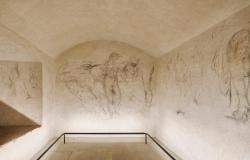We are in southern Umbria, almost in the immediate vicinity of the border with Lazio, and this is where we find it Orvieto, a designer village overlooking the surrounding valley, perched on a hill famous for its Gothic cathedral whose colorful façade is a true hymn to Italian creativity and artistic genius. Easily admired from the valley floor (if you have ever passed through these parts by train, you will certainly have playedOrvietospotting. Didn’t you know him? Until today, not even us, power of creativity), unmistakable with the harmonious mix of ocher and gold, it is a place that preserves many and varied places with the most disparate meanings. In short, a place to discover. Shall we leave?
Orvieto by motorbike. The itinerary
Map
Path
We leave the center of Bolsenalocated on the shores of the lake of the same name, and we take the SP53, which becomes SP54 in the direction of Bagnoregio. We reach the latter after taking the junction with the SP135 which leads to the village, while we descend on the SP6 towards the SP55. We continue until we cross the Lazio-Umbria border, and here we take the SP98, then SS448 which crosses the A1 motorway until Corbara. We skirt the lower part of the village, then reach Column passing through Big Bench #336. Another short stretch on the SR79 bis and we are in Orvieto Scalo. From here, reaching the village is possible both by motorbike and, in a scenic way, via the funicular.
You will fall in love with her: the 5 signature views of Orvieto
When you arrive in Orvieto, and more precisely near the train station (don’t worry, you can also get there by motorbike, not just by train), you see a funicular. A word which, moreover, lends itself to an erroneous interpretation: the rope is in fact not overhead, but between the rails. Elegant and refined red cabins, with 75 seats each, which depart every 10-15 minutes and connect Piazza Matteotti And Cahen Square, respectively the lower and upper part of the town. It is an unusual and original way (not in Umbria, here elevators, hectometric systems and so on are very frequent due to the particular regional orography) to reach a author’s village which will amaze you with these 5 author’s views
Orvieto Cathedral
An example of the preponderant elegance of Gothic architecture in Italy, the Cathedral of Orvieto (also known as the Cathedral of Santa Maria Assunta in Cielo) introduces itself with a façade decorated with colorful mosaics and intricate reliefs. Equally interesting is the interior, which houses fresco cycles of great scenic impact, such as the Chapel of San Brizio by Signorelli. The complex required overall three centuries of work and the facade, so beautiful and visible even from afar, was designed by Lorenzo Maitani.
St. Patrick’s Well

St. Patrick’s Well, historic Renaissance water well built by Sangallo
Work of genius Antonio da Sangallo the Younger, the Pozzo di San Patrizio is one of the most interesting places in Orvieto, a city that rests on a tuff rock, a stone of volcanic origin. It took 10 years to build it (1527-37), and to descend to a depth of 53 meters with two absolutely independent helical staircases. If it was once essential for watering the city even in the event of a siege, today it is a phenomenal tourist attraction.
Orvieto Underground

Etruscan caves under Orvieto for bird breeding and defense
Below the surface of Orvieto, there is an intricate labyrinth of tunnels and caves created from the hulls in the tuff. Underground spaces which were actually occupied for the first time by the Etruscans with the most disparate purposes, from military defense to food preservation. In short, when there were no refrigerators, the products were kept the same with natural coolness. Today the guided tours of Orvieto underground they allow you to get to know a city beneath the city made up of warehouses, cisterns and even oil mills.
Moro Tower

The relationship between Umbria and the papacy has always been conflictual. It is no coincidence that what we now call Torre del Moro was once there Pope’s Tower. A kind of ante-litteram skyscraper for Orvieto, 47 meters high and capable of offering surprising views over the entire city. Provided, however, that you face a short climb of 250 steps.
Claudio Faina Museum

Right in front of the Duomo and its magnificent decorations, the Claudio Faina Museum it is the other historical pearl of Orvieto, as it houses a rich collection of Etruscan and Roman finds, including ceramics, bronzes, jewels and coins. The Attic black-and-red-figure vases, which depict mythological and daily life scenes, are among the most precious finds in the museum collection, which offers an in-depth vision of the ancient history of Orvieto and Umbria.






